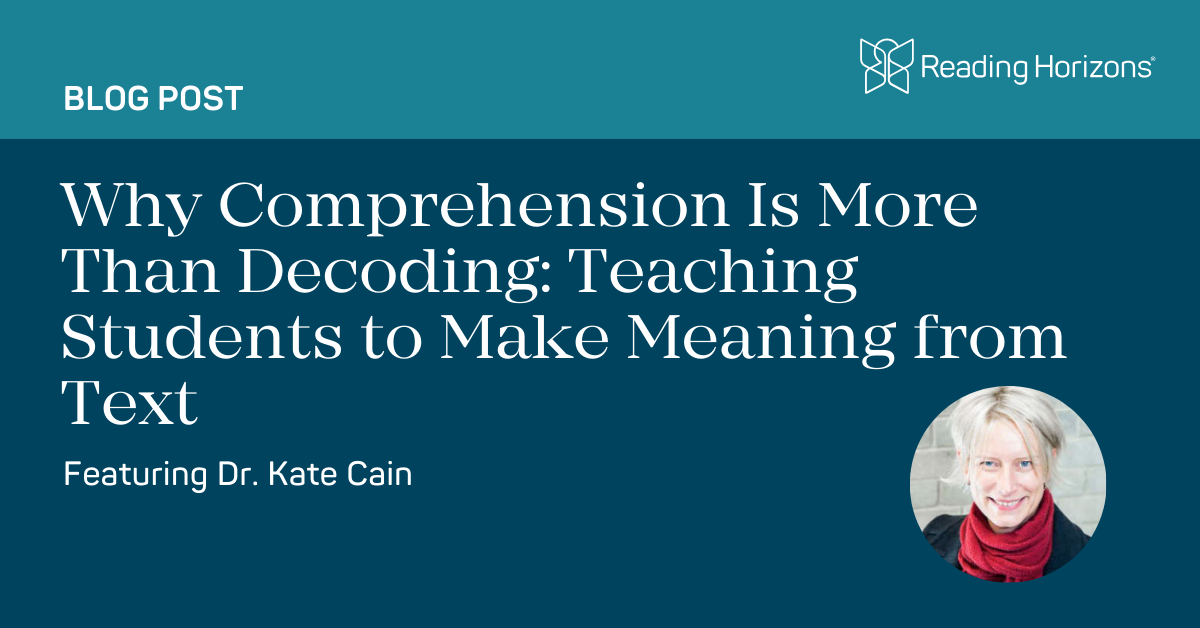Teaching Students to Make Meaning from Text
A conversation with Dr. Kate Cain, Distinguished Professor of Psychology at Lancaster University, United Kingdom
Reading comprehension is more than just saying the words on a page—it’s about what students bring to the text and how they actively construct meaning. In a recent episode of Literacy Talks, Dr. Kate Cain joined hosts Stacy Hurst and Donell Pons to unpack this essential yet often misunderstood aspect of literacy. Drawing from decades of research and practical experience, Dr. Cain explained why comprehension must be intentionally taught and supported, and how educators can tap into oral language, background knowledge, and well-structured texts to strengthen student understanding.
The Foundation of Comprehension: Oral Language Skills
According to Dr. Cain, a student’s oral language skills form the foundation for reading comprehension and written expression. These early skills, developed in preschool and at home, are critical in helping students access meaning in text later on.
Children who have better oral language skills—who know the meanings of more words, produce longer utterances, and can tell structured narratives—typically acquire stronger literacy skills more easily.
But while oral language lays the groundwork, it isn’t sufficient on its own. Educators must build on this foundation by teaching students to think critically and intentionally about texts.
Comprehension Requires More Than Reading the Words
A key misconception Dr. Cain addresses is that decoding alone leads to comprehension. In reality, understanding a text involves integrating vocabulary knowledge, background knowledge, sentence structure, and the ability to make inferences. Dr. Cain highlights the role of what she calls “considerate texts”—texts that provide signals and explicit information to support meaning-making.
You can read the words on the page and still need to engage in active effort to extract the meaning of a text.
Using a brief passage about a girl named Lily building a sandcastle, Dr. Cain illustrates how even a simple text can demand significant inferential processing. Readers must draw on prior knowledge—what a bucket and spade imply, what waves do at the shore—to understand why Lily ends up in tears.
The Power of Background Knowledge and Vocabulary
Dr. Cain explains how background knowledge can compensate for gaps in reading skill. If a student knows the structure of a baseball game, for example, they may better understand a text about baseball even with limited vocabulary.
That said, educators shouldn’t assume that strong oral vocabulary equals strong background knowledge. The two are related, but not interchangeable. This insight supports the growing movement toward content-focused instruction that builds both vocabulary and connected knowledge.
We can’t just give kids a list of vocabulary items and expect them to comprehend. We need integrated, content-rich instruction that helps them build a network of related knowledge.
Why Readability Formulas Aren’t Enough
Many schools rely on readability formulas to match texts with student reading levels, but Dr. Cain urges caution. These tools often focus on surface-level features like word frequency and sentence length, which don’t account for the deeper processing skills required to comprehend a text.
In fact, shorter or simplified sentences may hinder comprehension if they strip away important structure and cues like temporal connectors (e.g., before, after) that help readers follow a sequence of events.
Instead, educators should look beyond readability scores and consider whether a text includes opportunities for deep processing and connection-making.
The Hidden Richness of Written Language
Dr. Cain highlights how written language—especially in books—is richer and more complex than everyday conversation. Even children’s picture books tend to use more rare and diverse vocabulary than adult speech.
This makes reading not just a goal but a powerful tool for continued learning. The more students read, the more vocabulary they acquire, the more general knowledge they gain, and the better they become at reasoning and critical thinking.
Teaching Comprehension Intentionally
Comprehension and composition skills don’t develop by chance. They require intentional instruction. Dr. Cain emphasizes that just as we explicitly teach decoding and phonics, we must also teach comprehension strategies—like summarizing, identifying main ideas, making inferences, and analyzing text structure.
And it’s not just about teaching strategies. It’s about modeling a love of reading, too.
You’re never lonely with a book—you can escape into other worlds and perspectives, gain empathy, and experience a range of emotions and ideas.
Dr. Kate Cain
The Role of Teachers: Modeling and Motivation
Teachers have a vital role in fostering comprehension and a love of reading. Dr. Cain, Stacy, and Donell discuss the importance of modeling reading and writing behaviors—like reading silently alongside students or sharing your own writing in a classroom activity.
When students see adults reading and writing for enjoyment and reflection, they’re more likely to engage with literacy themselves. This kind of modeling helps position reading and writing not just as school tasks, but as lifelong, joyful habits.
Final Thoughts: Comprehension as a Lifelong Skill
In today’s complex world, comprehension is more than an academic benchmark—it’s essential for participation in society. From understanding healthcare forms to evaluating media, the ability to extract and construct meaning from text is a lifelong skill.
As Dr. Cain emphasizes, literacy instruction must go beyond decoding to help students become thoughtful, informed readers and writers. That means valuing the oral language they bring, carefully selecting texts, modeling literacy habits, and building instruction around deep, connected learning.
Explore more:
- Listen to the full episode of Literacy Talks featuring Dr. Kate Cain.
- Read Guilty by Definition by Susie Dent.

